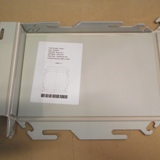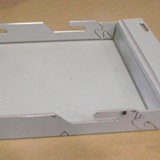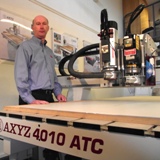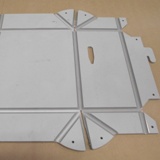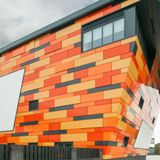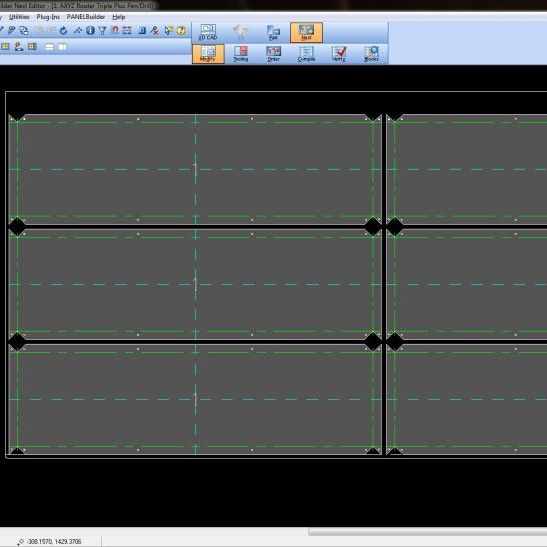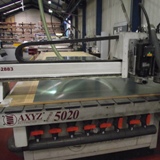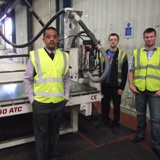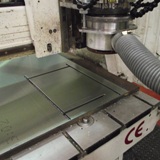 PANELBuilder Keeps Ash & Lacy’s Rainscreen Cladding Pendulum Swinging
PANELBuilder Keeps Ash & Lacy’s Rainscreen Cladding Pendulum Swinging
A company manufacturing rainscreen cladding from solid Aluminium and Aluminium composite sheets has completely automated the process of detailing and programming standard panels by using the combined CNC router and software solution, PANELBuilder.
Instead of panels having to be created one by one, they are mass produced.
“The machine is running constantly, swinging like a pendulum from one program to another.”
Matthew Day, Product Engineer
With contracts calling for a minimum of 200 panels, and often up to around 1,500, cut from sheets measuring 4.3m x 1.5m, PANELBuilder has proved invaluable since becoming Ash & Lacy’s first major investment in 2012 after a management buyout.
Now with an annual turnover of £30m, the firm’s history can be traced back to 1864, making it one of the oldest in the West Midlands. While Radpunch drives a turret press cutting a range of bespoke products including architectural features and bullnoses, louvres, flashings and rainwater management systems, RADAN’s specialist PANELBuilder software provides a parametric solution for thousands of protective panels.
Manufactured by Ash & Lacy’s AshTech Division, the rainscreen cladding systems are increasingly used on prestigious newbuild projects where both the guaranteed long-term performance and the aesthetics of the façade are of paramount importance. With many buildings needing thousands of square feet of panels, PANELBuilder, developed by RADAN, part of the Vero Software Group in conjunction with AXYZ International, is a dedicated solution for automating the manufacturing process and is distributed exclusively around the world by AXYZ.
Process Improvement Manager Tharinda Rathnapala says PANELBuilder automates the production of standard panels, which accounts for around 80 per cent of their work for public buildings such as hospitals, schools, colleges, and large apartment blocks. “We invested in the AXYZ Series 6030 machine to help meet our continued growth in the rainscreen cladding sector.” The PANELBuilder solution also forms part of their older AXYZ Series 5020 machine, which is best suited for cutting ACM, but is restricted by a smaller bed than the 6030.
New orders are normally received on standard order forms, detailing material, quantity, length, width and extrusions. “We transfer this onto CSV files, then our drawing office creates detailed drawings for the shop floor. Our two experienced PANELBuilder and RADAN detailers take the drawings and if they’re standard panels they’ll import them into PANELBuilder, or if they’re bespoke, they’ll go into Radprofile to create the individual program.”
Product Engineer Matthew Day uses PANELBuilder for all standard panels. “Once we’ve decided which machine the work will be going on I simply bring up the standard CSV template, input information about X and Y dimensions, quantities and material; set up a folder in PANELBuilder for storing the parts and import the CSV. Then it outputs all the panels for us.”
And he says the 6030’s pendulum machining capability with PANELBuilder is particularly important for increasing output and productivity by keeping downtime to an absolute minimum. This allows the machine bed to be divided into two ‘virtual zones’ so that a sheet is processed on one zone while the operator removes the parts and waste from the other zone, and loads a new sheet ready to be cut. “The machine is running constantly, swinging like a pendulum from one program to another.”
As well as being a complete CAD/CAM solution incorporating all the functionality needed for high volume panel production, he says PANELBuilder’s open architecture design means it can be readily used with other CAD systems. He uses Radprofile for unusual shapes and curves, along with bespoke panels which cannot be created from a standard template. “I draw those in Autocad, then import into Radprofile to tool and nest the job, as a good nest is vital for material utilisation and preventing wastage. We spend a lot of time on nesting and optimisation. For instance, just subtle changes to the way we manage clearances and how it’s laid out can make big differences. Sometimes just by adding a few mm to clearances can add three or four sheets to a job – that’s an extra two or three percent of material on a job.”
AXYZ Market Development Vice President Robert Marshall says PANELBuilder is a dedicated ‘one process, one solution’ system created for the niche cladding market. “The PANELBuilder CNC routers are designed specifically for processing large volumes of sheets in the fastest and most efficient way. The machine can be configured to suit a manufacturer’s exact needs.
“Parametric templates are built into it, so designers like Matthew Day simply have to select the appropriate sizes, quantities and stock size of the sheet. The software then creates all those panels, programming them automatically. Alternatively, data can be imported into PANELBuilder from spreadsheets or other CAD systems, but whichever system is used to mass produce standard panels for cladding, PANELBuilder has no comparison. Without it, manufacturers would have to use manual tools to cut every panel one by one.”
AXYZ’s software and machine support is carried out largely online. “We have a number of staff trained specifically on PANELBuilder who log on to a customer’s system and resolve the issue remotely.”
About the Company
Name: Ash & Lacy
Web: www.ashandlacy.com
Benefits Achieved
- Able to handle unusual shapes or curves
- Optimised nests
- Automatically creates panels
Comments
“The machine is running constantly, swinging like a pendulum from one program to another.”
Matthew Day, Product Engineer









